by Paul Warloski, Simple Endurance Coaching
With countless training methods and advice available, how can you simplify your approach and still get the best results?
We’ll explore six key pillars—Aerobic Training, HIIT, Strength Training, Nutrition, Sleep, and Mental Health—to help you focus your training efforts based on your goals and available time.

1. Aerobic Training: The Foundation for Endurance and Health
Aerobic training is the backbone of endurance sports.
It builds your body’s engine by enhancing mitochondria function, improving fat metabolism, and increasing capillary density.
Consistent aerobic work supports recovery, resilience, and durability while significantly boosting heart health and longevity.
Actionable Steps:
- Aim for two to four aerobic sessions per week at Zone 2 intensity (easy conversational pace).
- Utilize heart rate monitors, talk tests, or perceived exertion to stay in the optimal zone.
- Gradually increase session durations, aiming for 90 minutes or more at least once a week.
- Incorporate easy walks, hikes, or gentle rides on off-days to boost overall aerobic volume.
2. HIIT: Efficient, Powerful, But Manageable
High-Intensity Interval Training (HIIT) effectively enhances VO₂max, anaerobic capacity, and high-intensity performance.
However, it can heavily tax your recovery systems if overdone, potentially leading to burnout, overtraining, or injury.
Actionable Steps:
- Limit HIIT workouts to one to two times per week, particularly for masters athletes.
- Balance HIIT sessions with adequate aerobic training and dedicated recovery days.
- Perform quality intervals ranging from 30 seconds to three minutes, ensuring full recovery between efforts.
- Monitor your body’s signals: watch out for persistent fatigue, poor sleep quality, or sluggishness during workouts.
3. Strength Training: Essential Without Sacrificing Endurance
Regular strength training significantly reduces injury risk, enhances muscular power, coordination, and improves bone density.
It also boosts your performance in climbs, sprints, and late-stage race efforts, while combating age-related muscle loss (sarcopenia).
Actionable Steps:
- Strength train twice a week during your base training phase, reducing to 1–2 times weekly during competitive seasons.
- Prioritize compound exercises like squats, deadlifts, and push/pull movements.
- Keep repetitions low (four to six reps per set), moderate sets (generally two), and rest adequately between sets.
- Maintain proper form and avoid lifting to failure—consistency and technique outweigh maximum load.
4. Nutrition: Keep It Simple and Effective
Your nutrition plan should emphasize quality, timing, and proper fueling to enhance performance and recovery.
Prioritizing whole, real foods over ultra-processed items will significantly boost your athletic results.
Actionable Steps:
- Start your day with a protein-rich breakfast to support muscle repair and energy.
- Time your carbohydrate intake strategically around hard or lengthy training sessions.
- Ensure each meal contains 20 to 30 grams of protein.
- Maintain consistent hydration and incorporate electrolytes, especially during extended or high-temperature workouts.
5. Sleep: The Crucial Recovery Tool
Quality sleep is fundamental to recovery, adaptation, and performance.
Insufficient sleep blunts training effects, negatively affects cognitive function, and increases the risk of injury.
Actionable Steps:
- Aim for seven to nine hours of sleep nightly, establishing consistent bedtimes and wake-up routines.
- Create a relaxing pre-bed routine: dim lights, avoid screens, and engage in calming activities.
- Track your sleep patterns to optimize quality, not just duration.
- Incorporate short naps (20 to 30 minutes) if necessary to boost recovery.
6. Mental Health: Sustainable Performance and Motivation
Mental health is just as crucial as physical fitness.
Overwhelming training schedules can lead to burnout.
Recognizing that motivation naturally fluctuates, a disciplined yet adaptable approach is key.
Accept yourself on the days that you can’t do the workouts.
Actionable Steps:
- Schedule deliberate downtime or lighter training weeks, even without injury or fatigue.
- Dedicate five to 10 minutes daily to mindfulness practices, journaling, or focused breathing exercises.
- Regularly revisit your reasons for training to keep motivation high.
- Adjust your training plans proactively when life becomes stressful—adaptation and consistency matter more than rigid perfection.
By simplifying your focus on these six essential pillars, you’ll enhance your endurance performance and overall health without unnecessary complexity.
Three Things to Know About the Key Pillars of Endurance Training
1. Aerobic Training is Non-Negotiable
Consistent Zone 2 training builds metabolic efficiency, cardiovascular resilience, and long-term durability.
2. Don’t Neglect Recovery and Mental Health
Sleep and mental well-being are often overlooked, but they’re critical for adaptation, consistency, and long-term motivation. These “invisible pillars” can make or break your training.
3. You Don’t Need to Do Everything at Once
Focus on the 1–2 pillars that best support your current goals and available time. Smart training is about prioritizing the right inputs, not cramming in more complexity.
Need more?
Unlock the secrets to mastering gravel racing with my FREE 24-page Guide to Gravel Racing! Get yours here.
SIGN UP FOR A FREE Virtual Coffee so we can discuss your goals, ask questions, and talk about making your endurance training more effective, fun, and Simple.
Paul Warloski is a:
- USA Cycling Level 1 Advanced Certified Coach
- RRCA Running Coach
- Training Peaks Level 2 Coach
- RYT-200 Yoga Instructor
- Certified Personal Trainer




